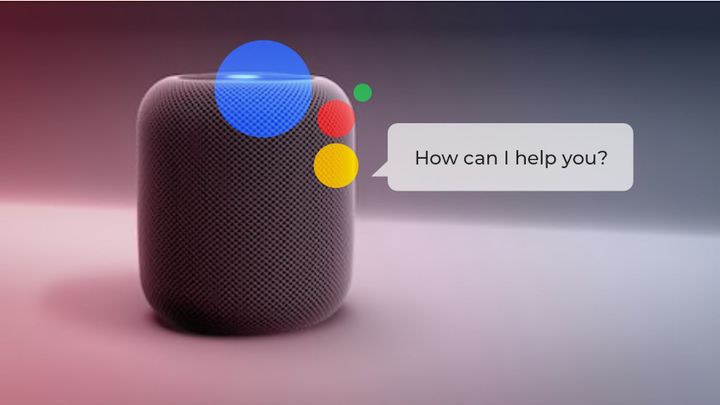
Brandy, a Generation-Z consumer, comes across an Instagram “like” by her friend for a featured dress. She likes the garment and is interested in purchasing it in a different colour. She decides to go online and compare prices, and while browsing, she is prompted to download the retailers’ app, which would result in a 10% discount off her first purchase. However, after comparing prices, downloading the app, and moving the dress into her “shopping cart,” she abandons her purchase thinking the dress isn’t the one for her.

A few days later, Brandy finds herself visiting the local mall in search of a new outfit for the Easter weekend. As she passes by the store location of the same retailer chain, she receives a notification on her smartphone offering her a “no obligation” discount subject to her visiting in-store to play an Easter Egg Hunt.

Excited to get in the Easter spirit and play the egg hunt in store, the retailers’ app on her smartphone intuitively prompts her to activate the “AR Buddy” mode so that she can begin the game, just as she would if she were playing Pokémon Go.
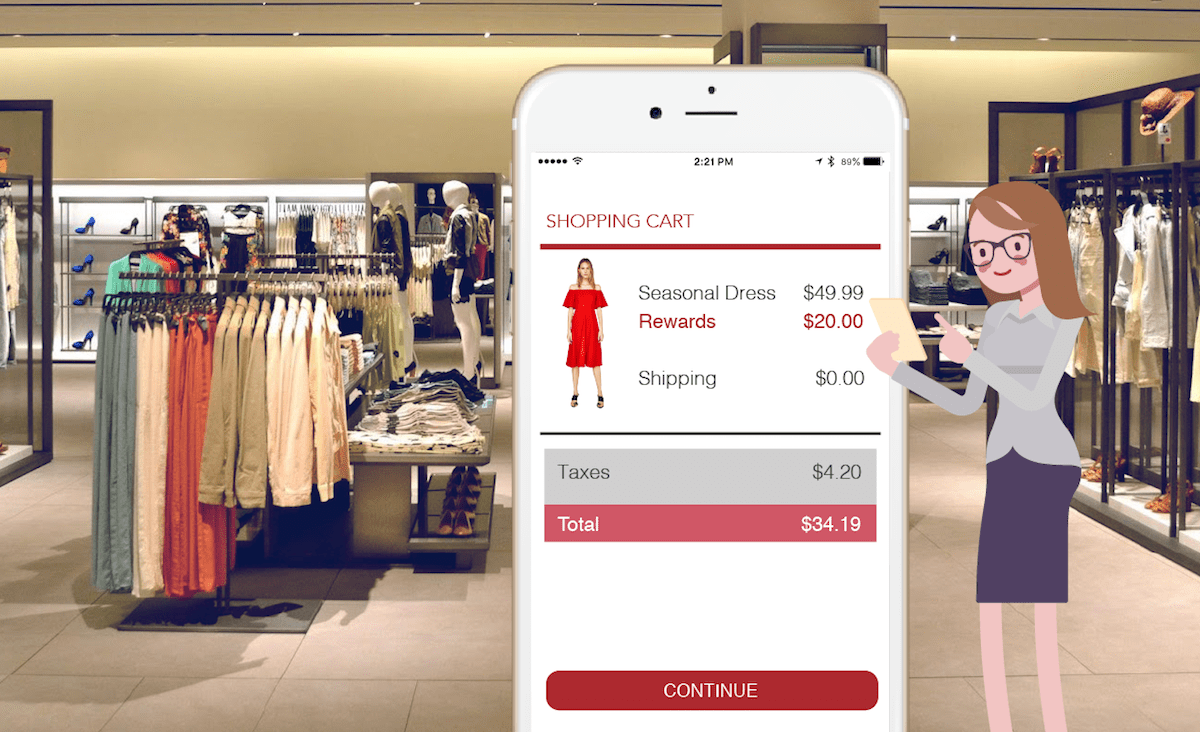
As she browses the store through the lens of her smartphone, she excitingly finds and “cracks open” a virtual Easter egg that entitles her to an instant rebate of $20 towards a purchase within the next three days. At the same time, she also notices the blinking icon of the retailer’s online cart, which still has the dress she selected a few days earlier. While on the fence before, with the added discount she thinks that buying the dress now makes for a great deal that is difficult to pass up.

Having placed the order, she is then given the opportunity to like the same dress on Instagram, entitling her to an additional $10 off her next purchase. Thrilled with the bonus promotion, she earmarks another dress she has come across while searching the store for the Easter egg, thinking to herself, “I’ll get this dress next time with the extra discount.”
PRO-Gamification
And that is how Personalized-Retail-Omnichannel Gamification (PRO-Gamification) works. From the moment Brandy logged into the app, the retailer’s back-end services platform started tracking her shopping experience. The social network API, merchandising catalogue, analytics engine, and Business Intelligence services all worked in tandem to track her clickstream, cart abandonment, and in turn, were able to predict Next Best Actions (NBAs). The fact that she compared prices hinted at her sensitivity to product pricing, and as something the analytics engine could hone in on, it predicted a higher statistical likelihood that if offered a discount or promotion, she would convert.
When Brandy passed by the retailer’s brick-and-mortar store, it gave the retailer an ideal opportunity to get her attention. Beacons placed at the store entrance helped the mobile app sense her proximity and signalled the retailer’s back-end services to deliver a targeted promotion as a push notification. Given the season, however, this was no ordinary promotion, which immediately caught Brandy’s attention. The egg hunt provided the perfect reward mechanism to convert her into a paying customer. The cart history with the dress she had selected earlier helped “firm up” the purchase by avoiding manual searches online or the need to ask a sales associate for help.
Furthermore, beacons located strategically throughout the store helped her “find” her Easter egg in proximity to items she would likely prefer to buy – something determined by the analytics engine based on her prior search. Beacons also enabled the mobile app in helping her locate and earmark the new dress in the online catalogue. In fact, now she is almost tempted to purchase the other dress directly from the store’s Point-of-Sale (POS) as she can take advantage of the extra $10 promotion because it is her next purchase anyway.
Brandy’s entire journey, from searching online, purchasing, and sharing her positive experience on social media not only triggered “impulse buys” in real-time, but it also turned her from a prospect into a repeat customer and brand advocate. And now that the retailer has established predictable behaviour markers, they can personalize her future shopping experiences.
Quick links to key sections
- Gamification, Past and Present
- Gamification as a Unified Marketing Strategy
- Towards an “Everything Digital” Approach
- Identifying Customers Individually to Personalize Content
- Understanding Customer Sentiment in Omnichannel
- Melding Art and Technology to Create Memorable Experiences
- Bringing Experiences to Life via Storytelling
- The Value of PRO-Gamification in Retail
Gamification, Past and Present
Gamification in retail is not a novel concept; however, with consumers being more connected than ever before, the notion is quickly becoming an imperative. With the rapid increase in digital connections leading to increased speed and convenience across all aspects of life, the question now raised is how and where to deploy resources for digital initiatives effectively and efficiently and how to apply them towards gamification. Digital transformation itself has evolved into a priority stack comprising the Internet of Things (IoT), Design Thinking, and Artificial Intelligence, and retailers need to act accordingly.
Simply put, gamification is the use of elements of play and reward to affect and influence user behaviour; and with this evolved stack, it is quickly becoming the new retail battleground to win and grow customer base.
So why does it work? Well, at its most basic level, it can trigger positive emotions, mainly those associated with play and reward. And if you have followed our past article on customer experience, you know these emotions are fundamental in capturing user’s attention and commitment to a purchase transaction.
Gamification as a Unified Marketing Strategy
Although the gamification of shopping experiences is not yet mainstream in the retail paradigm, it can be applied towards any product or service, regardless of the stage in the customer journey. Not only that, but the process can be easily adjusted, regardless of requirements, and can be scaled to almost any budget as part of a strategy to lead potential customers towards the desired goal along their journey.
At its core, the appeal of gamification is to provide the users with a sense of control. Similar to a game where participants get a reward – a new character or power-up for example – for completing a level, gamification taps into our brains inherent reward mechanism, thus helping to reinforce a specific habit or behaviour.
For putting together a bundle of products or services, this technique has proven hugely successful.The modern consumer is short on time, especially when it comes to processing the volume of content required to select and purchase the right collection of products or services. By turning that identification into a gamified experience, the natural attention of the user is enhanced. This method also drives higher customer engagement and increased brand loyalty through the implementation of such customer-curated collections. This also has a positive impact when you are rewarding your customers with loyalty points for activities – such as store visits, product videos watched, products reviewed, or purchases made – and provides far more information on consumer habits and the shopping cycle across multiple channels, which can, in turn, drive future sales.
According to a set of recent surveys on mobile POS and retail gamification, retailers plan to use enhanced gamification features, incentives, and loyalty program tactics in their mobile strategies. Furthermore, some studies suggest that a substantial number of retailers plan to identify customers when they walk in the store, and that customer experience and engagement are one of their top customer relationship management priorities. However, such undertaking cannot be effective or profitable without carefully implementing a gamification framework with the following key points in mind:
- Moving towards an “Everything Digital” Approach
- Identifying Customers Individually to Personalize Content
- Understanding Customer Sentiment in Omnichannel
- Melding Art and Technology to Create Memorable Experiences
- Bringing Experiences to Life via Storytelling
Towards an “Everything Digital” Approach
New ways to interact over digital channels give you new opportunities to engage with customers at an unprecedented level. For example, there was once only the need for call centres to handle remote purchases and support, but with the advent of smartphones, apps can now serve customers directly. This has also allowed for a significant shift in customer experience and expectations due to new devices like wearables, voice-based assistants, and even augmented and virtual realities. It is essential to appreciate that in a digital transformation (and, for that matter digital business) all contexts arising from functions, processes and interactions are in fact interconnected and should be treated thusly.
Customers now expect interactive experiences on these new devices rather than relying on conventional methods of accessing content. With the help of big data analytical capabilities, retailers can turn enormous structured and unstructured data into actionable customer insights. “Big data” with the right analytics can enable retailers to develop enriched 360°customer profiles, establish customer-centric KPIs, and develop more targeted offers.
Retail Presence in the Digital Domain
Specificity of interactgital domainion is extremely important within digital experiences. For example, studies have found that the app conversion funnel is wider at every point of contact than conventional and mobile web. In particular, app users were found to browse four times as many products than those on mobile web; indicating that app users make for more loyal and dedicated customers. From that larger base, customers are almost twice as likely to add items to their basket in an app than in a mobile browser.
Applications and targeted interactions not only convert a higher percentage of your customers, but they also bring in more revenue per transaction. Controlling this environment can allow you to engage customers through verbal responses, videos, images, reviews tailored to personalized elements such as buying history and browsing behaviour within mobile apps, on social media, as well as in direct interaction with you. In fact, each channel can yield multiple touch-points to track individual customer engagement and sentiment as shown below:
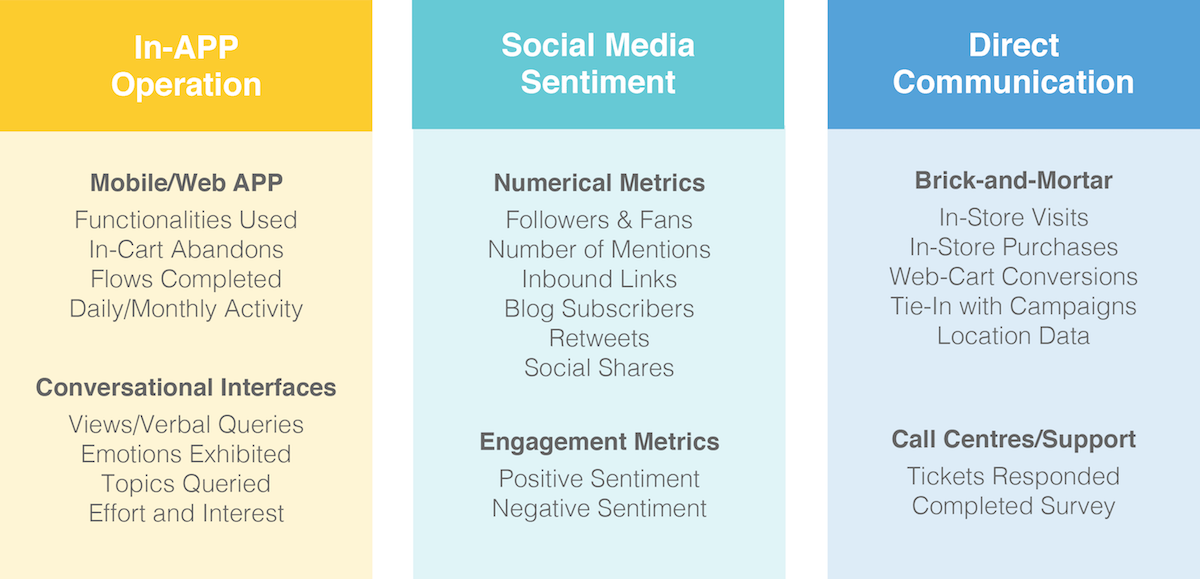
In-APP Operation in Mobile/Web APP are Functionalities Used, In-Cart Abandons, Flows Completed, Daily/Monthly Activity and in Conversational Interfaces are Views/Verbal Queries, Emotions Exhibited, Topics Queried, Effort and Interest. Social Media Sentiment in Numerical Metrics are Followers and Fans, Number of Mentions, Inbound Links, Blog Subscribers, Retweets, Social Shares and in Engagement Metrics are Positive Sentiment, Negative Sentiment. Direct Communication in Brick-and-Mortar are In-Store Visits, In-Store Purchases, Web-Cart Conversions, Tie-ln with Campaigns, Location Data and in Call Centres/Support are Tickets Responded, Completed Survey.
On top of that, IoT has made it possible for all connected devices and touchpoints to affect the customers daily life. It integrates data gathering sources, assembling data strategy and analytics for better-informed decisions; designing products, experiences, and businesses with a focused human-centred approach, all while identifying patterns and providing personalized experiences. Web and mobile are no longer the most significant source of data generation; rather, it is being generated by the apps we use and by the way we interact with smart devices including wearables, cars, cameras, and routers to name a few. According to recent studies digital businesses will be leveraging IoT for in-store experience in addition to mobile and web channels with less than 20 billion connected devices today to 30 billion in 2020 to 80 billion in 2025.
Leveraging Mobile App-Centric Touchpoints
According to a recent survey, mobile touchpoints remain relevant as the gap between, consuming analytics content on a desktop computer versus a mobile device, has all but vanished. This diminishing gap is even more apparent between smartphones and tablets. Traditional means of data delivery and presentation cannot be taken for granted. Instead, innovation is necessary for finding new ways to harness strategic data assets with cutting-edge tools for faster and better-informed decisions.
Digital transformation does not change the value proposition for mobile innovation, in what I call the “Triple-A” of mobile analytics: Anywhere, Anyplace, Anytime. Via app Software Development Kits and Application Programming Interface (APIs), any data, whether structured or unstructured, big data or small data, on-premise or in the cloud, can be captured.
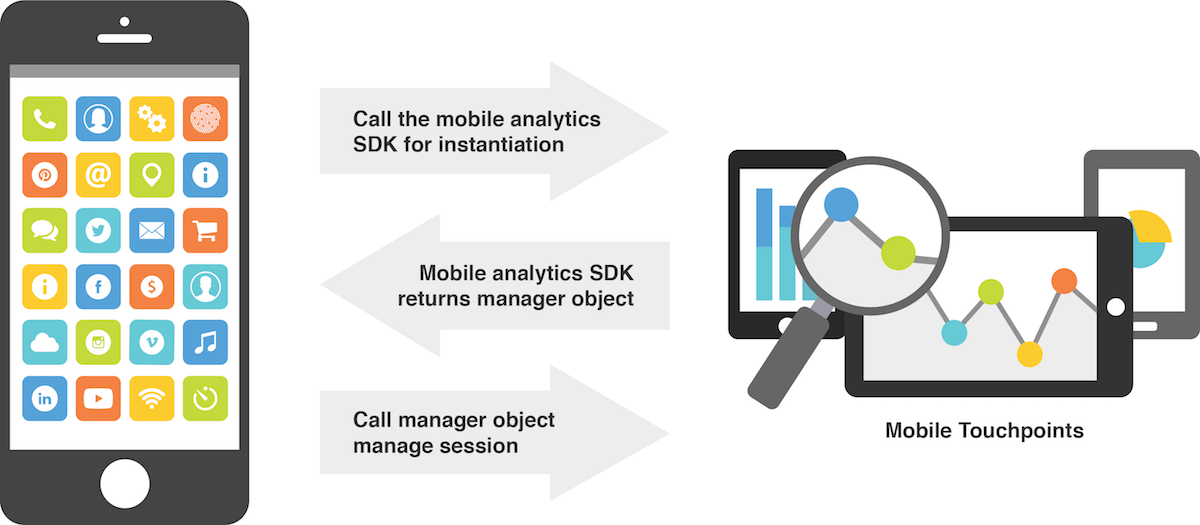
The digital economy demands a mobile-first approach to maintain the strategic value in order to turn insights into action.
Identifying Customers Individually to Personalize Content
Personalization is a growing trend that enhances the customer experience, and its core is the ability to identify and remember the customer uniquely. This allows retailers to make interactions more accessible and more intuitive, as well as target the customer based on their specific behaviours. You must analyze and realize what the customer wants most – convenience.
Limitations of Third-Party Analytics Tools
Popular analytics tools (such as Google Analytics) help identify user behaviour through cookie-based tracking. However, one should note that cookies are site-specific, and therefore subdomain or cross-domain tracking needs additional effort. Since cookies are not shared cross-domains, every interaction of a single user across different devices is recorded as activities by unique users in the absence of user identification. For instance, a visitor researching a product on your website decides to subscribe to your newsletter a week later and purchases a product a month after that. All of these interactions count as the activities of three different users. Therefore, third-party analytic frameworks end up being completely ineffective in identifying unique customers who choose to use multiple devices or browsers across visits to a site.
Generating Individually Identifiable Analytics
Integrations between identity management solutions and Data Management Platforms (DMPs) or automation tools make it possible to link existing, anonymous consumer data to known user records once a user accesses a site via a registered session on-site. Using probabilistic models, the user’s identity data will be passed directly from the identity management platform to the DMP and attributed to the correct user based on the site ID match – even across devices and domains. A User-ID in Google Analytics is a unique set of alphanumeric characters that is assigned to a user to identify him/her across multiple devices uniquely.
Considering the previous scenario after implementing User-ID verification, and the same visitor performing the same actions can now be recognized as a single unique user:
- User-ID makes it possible to implement cross-device tracking because it associates sessions across multiple devices to a single user instead of multiple unique users
- By setting up User-ID, you can gain access to cross-device reports in Google Analytics
- User-ID will help you understand the relationship between multiple devices and engagement between sessions, which is essential when developing new marketing campaigns and their gamification
To track users across multiple devices, you need to assign custom User-IDs to site visitors by changing in the analytics tracking source code. However, you would also need to add code that would pull any session-specific (login) IDs from the authentication system and send to Google Analytics as the User-ID. Finally, to view and analyze data from sessions in which a User-ID is detected, new views can be created showing cross-device reports.
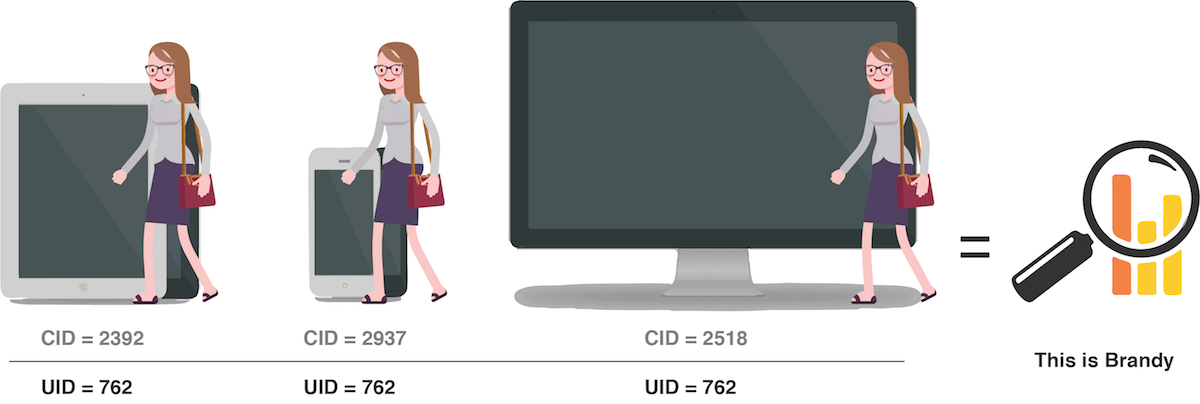
These reports can provide much-needed insight into user engagement on multiple devices with multiple sessions. They can also be considered as a breakdown of the activities users participate in during each of their sessions, which can further enhance game and level design for retail experiences.
Understanding Customer Sentiment in Omnichannel
The interdependencies of all the channels available must be understood thoroughly because customers want consistency across channels. For instance, customers want to continue their shopping experience where they had left off whenever they switch between channels. In the retail scenario, brick-and-mortar stores are associated more with customer service. This face to face advantage obviously shifts when specialized cross-channel journeys are considered, such as searching online but purchasing in-store, and vice-versa. For instance, you may find that limited sales are occurring via social channels and wrongly conclude them as ineffective. But, when viewing the entire journey across channels, you may discover that social channels are in fact a critical influencer of sales.
The result of appreciating such consumer behaviours have a profound impact on marketing strategies, especially when the customer is no longer viewed within a single channel. Rather, each channel must be considered a driver for conversion in a different channel, and loyalty or fulfillment in yet another – all as a part of an omnichannel (interdependent) journey.

This creates a clear, single view of the consumer, which will enable you to interact across all available channels. Taking advantage of better customer information, delivering consistent quality of service, and personalizing the customer experience, you can evolve your customer-centric business plan-of-action and enable all your channels.
Analytics for Decision Support
The most prevalent method of data storage for business is in silos across a variety of new and legacy systems. This lack of consolidation makes gleaning meaningful and timely insights difficult, if not impossible. Moreover, the analytical approach used by most companies is channel-specific, hindering them from getting a complete picture of the end-to-end customer journey. Remember, consumers are constantly producing data about their likes and dislikes, channel preferences, product choices and more; and to capture it, you must be prepared to glean data from website visits, email opens, social interactions, forms completed, purchases and so much more.
Choosing to view this data in channel-specific silos can be misleading. To reach customers with a level of relevance that grows conversions and loyalty, you must first understand your customers. Advanced analytics, though at the heart of this approach, is more than just a new name for business intelligence. With advanced data architectures, you can now store new types of data, retain that data longer, and join diverse datasets together to gain new insights, not only to describe and summarize results but also to create possible futures based on-time-sensitive decisions and to predict likely outcomes.
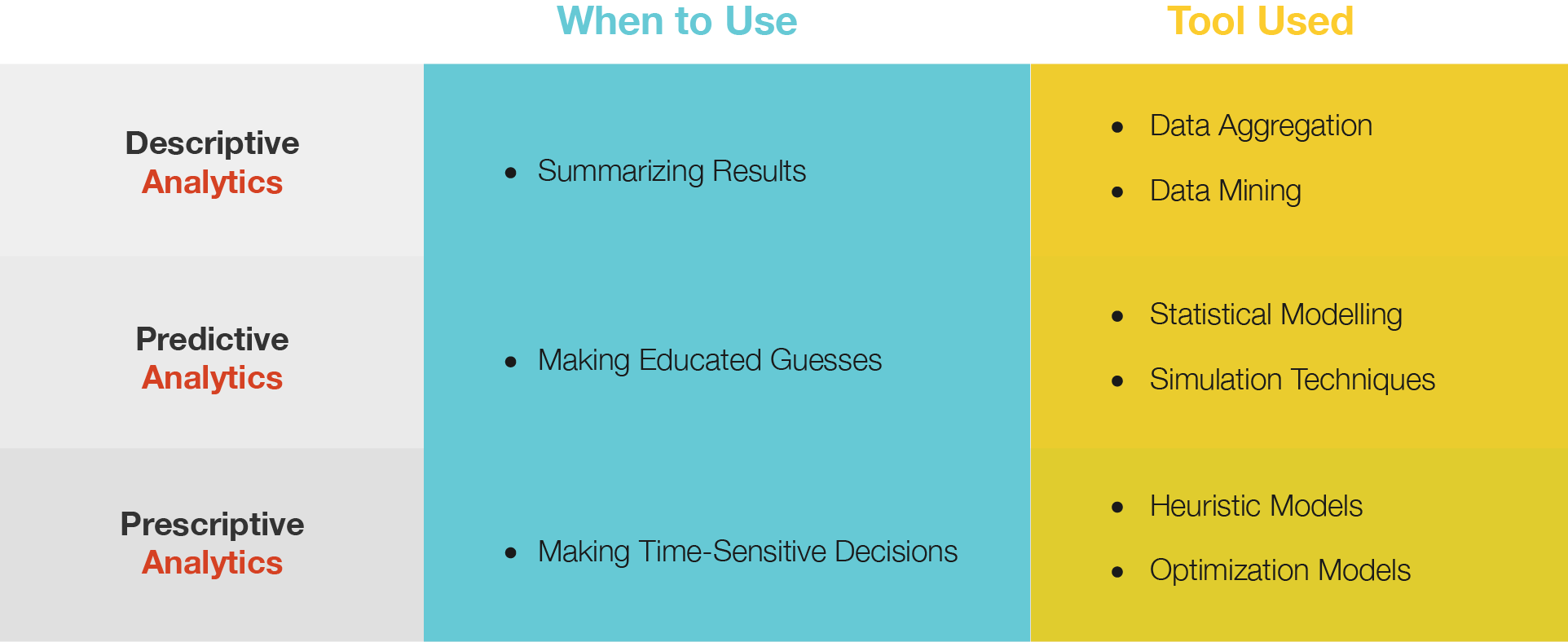
Descriptive Analytics are used when Summarizing Results and tool used Data Aggregation and Data Mining. Predictive Analytics are used when Making Educated Guesses and tool used Statistical Modelling and Simulation Techniques. Prescriptive Analytics are used when Making Time-Sensitive Decisions and tool used Heuristic Models and Optimization Models
Insights gained from big data analytics, improve the customer experience at every touchpoint through high-performance services, fast feedback and customized offerings. Today’s advanced big data analytics can allow you to unlock new insights in real-time, enabling you to proactively offer products and services to your customers at the exact time they are most likely to subscribe, buy, or respond. This will lead to a proactive retention approach through analyzing mobile/web interaction, social media sentiment as well as direct communication based on combining customer churn prediction and marketing action optimization.
You can go beyond “actionable customer analytics” to automatically determine what marketing action should be taken for each at-risk customer to achieve the maximum degree of retention possible – and create a customer experience that is unparalleled in the industry.
The Role of Machine Learning in Analyzing Customer Behaviour
Machine Learning and Artificial Intelligenceare extremely useful in deciphering the data captured from each customer interaction and can be used to predict the likely outcome of each event several steps down the line. For example, outcomes may be customer satisfaction or dissatisfaction concerning a product sale or call centre incident. Based on the sum of these calculations for the customer, or the customer segment, the system will determine and recommend the highest probability actions to take for marketing, sales, or support scenarios.
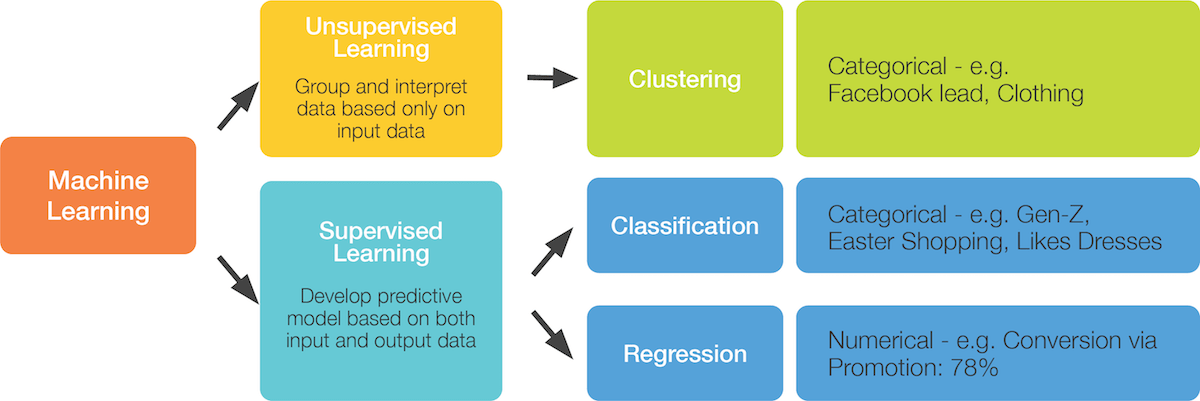
One of the main applications of machine learning – to drive customer engagement – is in market segmentation. In the absence of labelled real-time data, a subset of these techniques (called unsupervised learning) is very useful in advertising, implementing strategies for customer engagement and so on. By intimately understanding the intricacies of measuring and analyzing the customer experience throughout the journey, you can apply advanced diagnostic, predictive, and prescriptive analytics that – when combined – provide additional insights into business-level problems. While unsupervised learning allows for a wide degree of applications in making sense of data without labels, it is only advised if some level of association can be made across customer data. The low-hanging fruit for a machine learning use-case is likely to spawn from historical and labelled data available to you.
However, not all Machine Learning models are optimal for a given set of problems and associated data. For instance, supervised learning techniques constitute a different mechanism of deriving insight from existing and known (training) datasets. This can be thought of as a teacher supervising the learning process.
When it comes to decision making, Machine Learning can not only provide insight into what actions to take but also into what actions that should be avoided. The value of Machine Learning, therefore, lies in spotting connections between channels that would otherwise go completely unnoticed and then surfacing those connections for you to take action. This can come in the form of automated recommendations and gamified experiences that increase the chances of consumers purchasing additional products, or as follow up marketing activities like an email offer for one of the associated items.
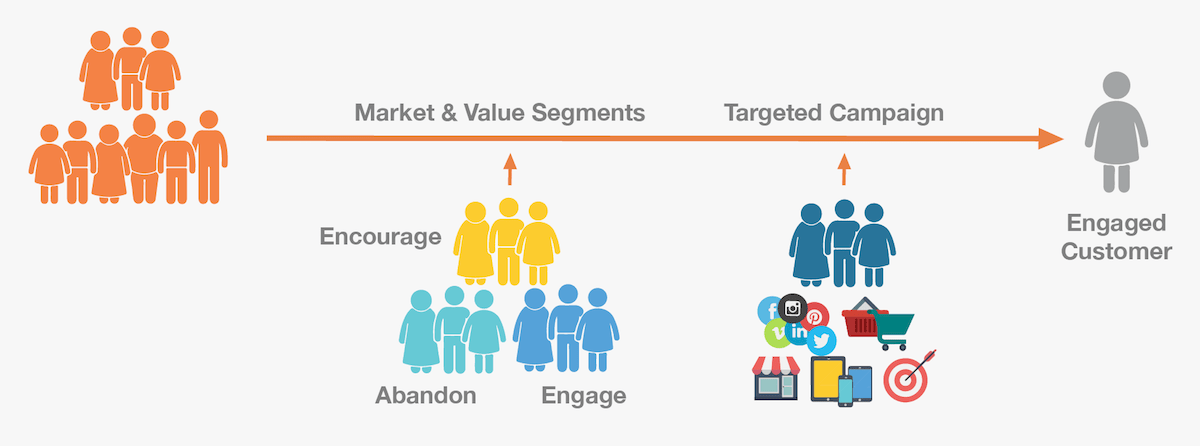
All of this data is ingested by several algorithms powered by statistical and Machine Learning techniques for suggestion and decision support. Approaches use both supervised learning (e.g. classification, regression) and unsupervised (e.g. dimensionality reduction through clustering or compression) machine learning techniques. For example, Netflix and Amazon Prime use similarity/proximity-based algorithms to generate recommendations based on (video-to-video views) in a “Because You Watched” section. A personalized video ranker algorithm, or PVR, selects the order of videos in genre rows, using an arbitrary subset of the Netflix catalogue. These short-term trends are powerful predictors of videos that Netflix customers watch for example, especially when combined with personalization.
Occasion-Based Campaigns
The use of occasion-based campaigns, be it for your catalogue or targeted and personalized advertising, can be a powerful tool for decision support as well as customer engagement and retention. At the individual customer level, NBA can be identified based on the offer acceptance rates of similar customer types and their willingness to convert during specific events or holiday seasons.

With each customers acceptance or rejection of an offer, the system can then update and adjust the NBA algorithm and predictive model. In essence, the ability to learn, adapt, and predict customer responses to your actions during specific events or occasions can significantly increase the likelihood of new customer acquisitions as well as retention of the existing customer base.
Predictive NBAs and Branched Futures
The customer journey in an omnichannel experience is considerably different than that of traditional multichannel. Studies have shown that almost 60 percent of online customers now expect retailers to approach them with value propositions ‘relevant’ to them – which would undoubtedly also be true if the same personalization experience were available to customers at bricks-and-mortar stores. Customers no longer want to review a generalized list of products and service offerings. Rather, they prefer insights into how features of those products and services will add more value to their day-to-day lives and why they should choose yours over a competitor. Knowledge transfer is best achieved through a gamified experience that is sensitive to choices made by the customer and the nuances that can be derived from the social setting in which those choices were made. Using this paradigm, “multiple-future” scenarios and storylines can be designed such that a set of choices, though not evident in their relationship between retail channels, can, in fact, be cross-linked.
In the case of Brandy, her journey began online with social media, followed by a click-through to the mobile app. And though the order placement was still done online, her physical presence at the retail store acted as a catalyst. Similarly, a different scenario can also be mapped to a journey where the transaction occurs at the brick-and-mortar POS, but the catalyst is online searches and social media interactions. The ability to map and transition between journey points from channel to channel is at the heart of predictive NBAs, and the main driver behind interactive retail gamification.
Melding Art and Technology to Create Memorable Experiences
Omnichannel interactions can provide the customer with constant communications across their journey, one where the conversation history and context travels with them from channel to channel. But the context for omnichannel experience is non-trivial to maintain across many disconnected communication channels, from chat apps like Facebook Messenger, WeChat, and WhatsApp, to email, SMS, mobile and web chat. In the case of a Telecom Operator as an example, true omnichannel would mean giving the operator the ability to interact with the right customers, in the right places at the right times, all without having to sacrifice context. Omnichannel APIs can easily transfer the conversation from a chat app to in-app or web chat, from an email to SMS – or any other combination whether the customer is looking to upgrade a wireless device, change a plan, or request support. The operator can provide customers with a set of choices for where they would like to continue the conversation or get notified of a reply later on.
AR/MR-based Interaction
Perhaps the most significant opportunity for omnichannel marketing is the ability to create virtual versions of real products so consumers can enjoy an ultra-realistic shopping experience. While conversational interfaces are proving to be invaluable in engaging the user to intuitively access content and assist in decision making, such interfaces are limited to text- or voice-based chatbots. However, conversational interaction for Augmented and Mixed Reality (AR/MR) will be fundamentally different due to the enriched content rendered within an arbitrary 3D space. Free from the confines of a 2D “flatland,” the UX of the future will demand digital content to be more than what is currently accessed over the web. UX designers and developers will need to prepare content generation and digital assistants for verbal, as well as gestures, to interact with the users; not just by displaying audible or visual content, but by introducing key micro-interactions through evolutionary storyboarding that trigger the user’s active thought process.
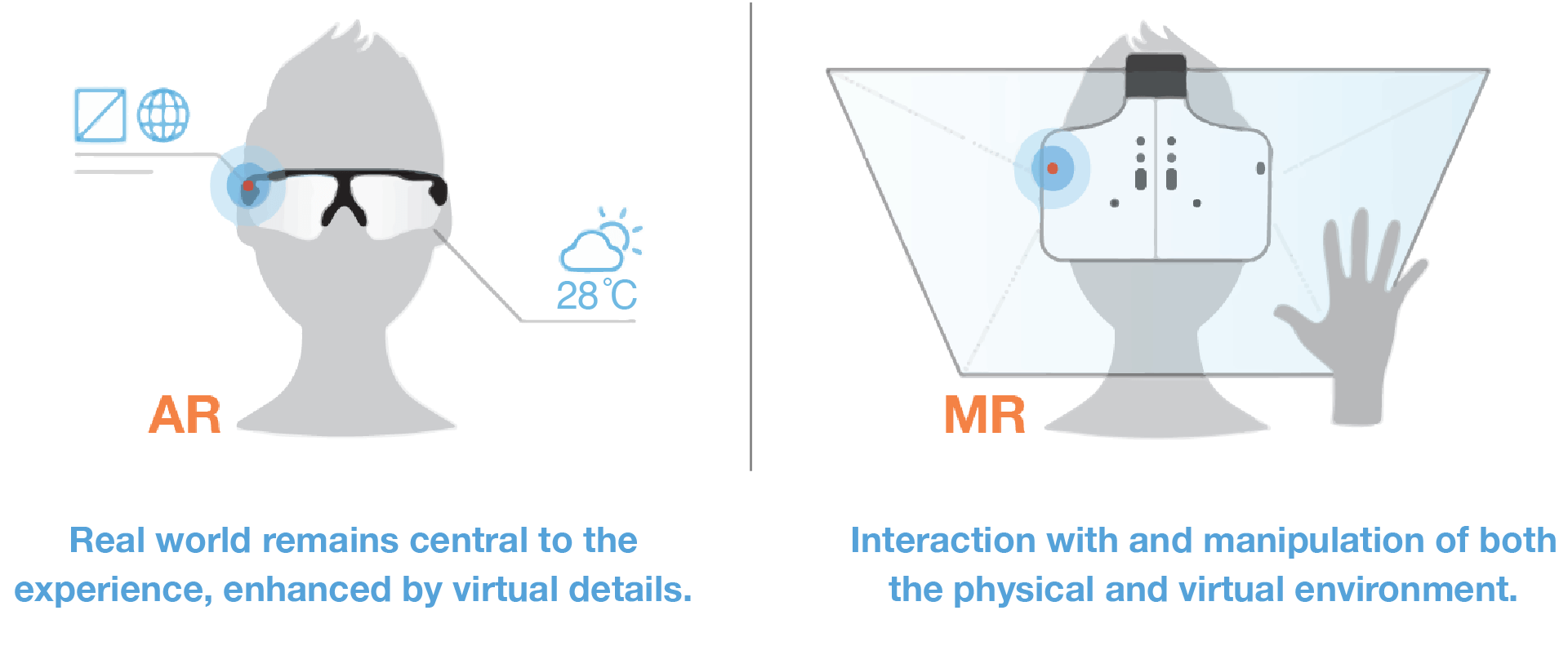
In AR, Real world remains central to digital experiences, enhanced by virtual details. In MR, Interaction with and manipulation of both the physical and virtual environment.
It is estimated that approximately 67 percent of people who enter a fitting room in a store will likely make a purchase. Using technology to overcome this physical hurdle, Dressing Room apps use such technology that can allow people to virtually “try on” clothes, all without setting foot in store. After selecting a product on the virtual shelf, customers can select their size and the size of the garment to get a better idea of how the clothes will fit – which adds another dimension to gamification.
Furthermore, the recent success of AR apps such as Pokémon Go has presented new possibilities in how such technology can be beneficial, especially if Brandy’s journey of the egg hunt is taken into consideration. Retailers can use similar tools to boost local customer engagement through AR mobile apps that encourage loyalty rewards.
The Role of Proximity-Based Beacons and IoT Devices
Beacons are battery-operated wireless devices that transmit Bluetooth signals to nearby smartphones. In the context of retail, beacons reach out to customers that have Bluetooth enabled and the right retail apps downloaded onto their phones. Beacon technology is a new way to engage with consumers and provide incentives for shoppers to enter a particular store, stay for a while, and make purchases. Their continued rise in popularity is expected to help reinvigorate brick-and-mortar retailers, offering customizable shopping experiences to customers that cannot be replicated online.
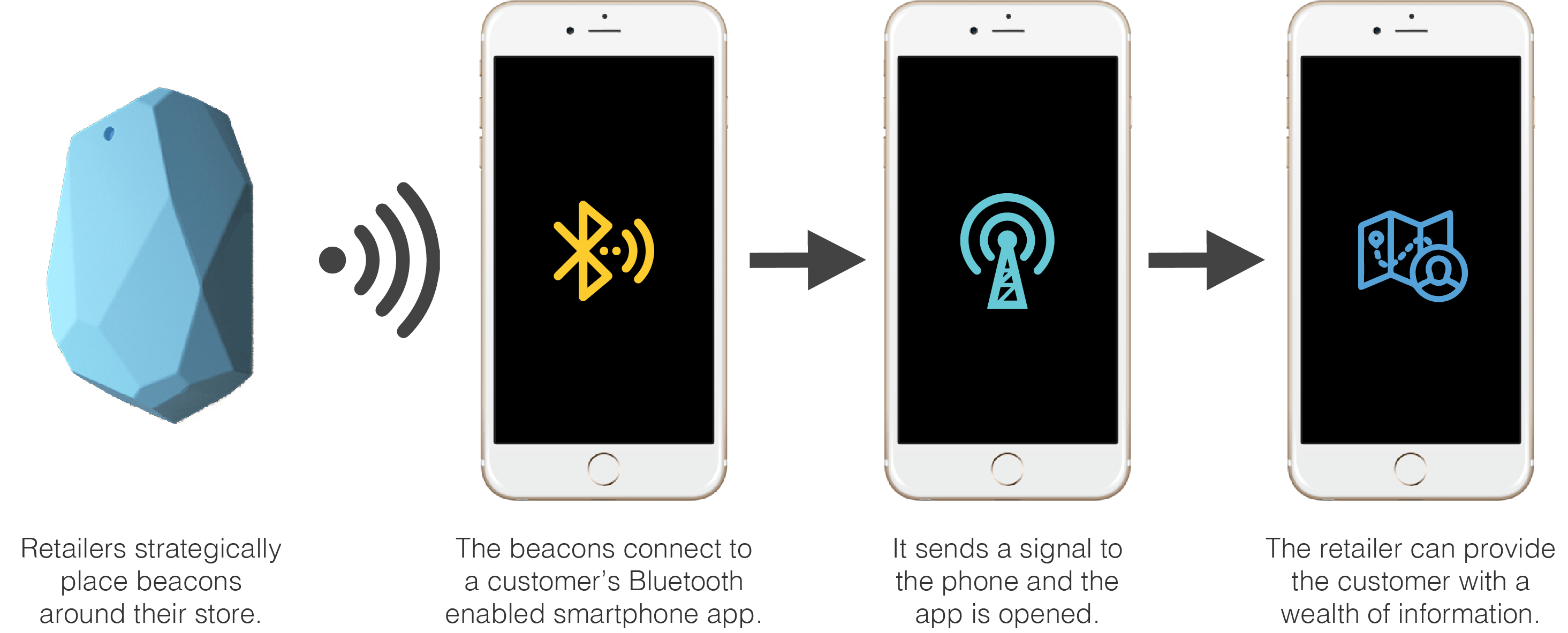
Retailers strategically place beacons around their store. The beacons connect to a customer’s Bluetooth enabled smartphone app. It sends a signal to the phone and the app is opened. The retailer can provide the customer with a wealth of information.
Bringing Experiences to Life via Storytelling
We are creatures of emotion. As such, naturally, the best gamification experience would create a sense of fun, happiness, and excitement for us. However, this is only possible with a quantitative measure of such sentiment, corresponding motivators and expectations, and the game mechanics that influence them. Analytics can be combined with customer data to predict behaviour and personalize gamified experiences in real-time. This can be achieved with a combination of:
- Your merchandise catalogue
- Potential customer’s presence proximity to your store
- Available inventory in that store
- The user’s past behaviour and current patterns
These elements can provide insight into a customer’s needs and suggest possible products and services to address those needs in real-time. A text message, email or in-app notification could be pushed to the customer’s device (if known) with promotional offers to help them with their purchase.
Establishing a Story
Stories are fundamentally engaging and have grown into a safe harbour for us to experience loss, or more accurately, perceived loss. Based on the Freudian hypothesis of recovery and loss, such dramatizations enable the engaging power of stories and their application in gaming.
Web and game developers have drawn on story-based strategies to enhance engagement with their audience. This strategy can draw on elements of game-play to optimize interaction with marketing and branding campaigns. Fundamentally, game-playing structures revolve around the theme of winning and losing, and create a perceptual “tension” of loss if a particular action is not taken. And this deep-rooted similarity to the very structure of emotional experiences is interpreted by the human brain as a potential risk that must be addressed by putting in the necessary effort. The outcome is automatically interpreted by the brain as an accomplishment.
Building a Rewards Program
We love being rewarded, whether in the form of discounts, points, or bragging rights. Rewards are naturally a part of retail because completing a purchase can already feel like we have walked out triumphant with a prize in hand. Building on customer engagement and brand loyalty by developing a tiered rewards program can further enhance this sense of reward, where customers can perform certain actions to inch their way towards a highly desired milestone.
One style of a rewards program is to gain loyalty points. You can make use of such loyalty programs to encourage shoppers to make purchases. When a certain number of points are earned through purchases, they can be redeemed for discounts or virtual cash to spend at the store. At other times, such discounts could even be offered immediately to prospects just to get them “in the door.” However, the timing of the offer, the relevance of the reward, and the perceived value must be immediately obvious to the buyer, yet subtle enough, so it does not appear as forced.
Making Games Relevant to Customers’ Locale and Timing
Today’s customers rely heavily on social media to discover new products and brands and use mobile messaging apps to get feedback from friends about potential purchases. You can get customers to download your app by integrating social features and seamless sharing. For example, clickthrough and downloads can be achieved rather easily by deep-linking social sub-apps (e.g. messaging platforms) to the main app or its download location on the smartphone’s store. Once downloaded, the gamification of retail experiences can take shape rather organically. However, it should be noted that gamified promotions are only as good as the person they are offered to, the timing they are offered in, and the location they are offered at.
The Value of PRO-Gamification in Retail
While undoubtedly influential on Brandy’s behaviour, the “Easter egg hunt” should not be mistaken for gamification; instead, it was just a brief component within an elaborate and interactive implementation of PRO-Gamification. This gamification will lead you to a sustained stream of recurring sales, increased customer loyalty, and new and personalized customer engagement – precisely what consumers are demanding from their brands. The trick is in how you gain insights into customer behaviour, use location and timing cues to trigger customer engagement, and test new promotional strategies, while keeping the overall experience as relevant and meaningful to customers as possible.
PRO-Gamification will empower you to generate more customer engagement across all channels, gain valuable insights into your behaviour, and bring more bodies into brick-and-mortar locations – but it does require careful planning and execution. That is unless you are the consumer, in which case, it is all just fun, happiness, and excitement.
To win, you have to play. To implement the new retail imperative
 Take me back to quick links
Take me back to quick links

